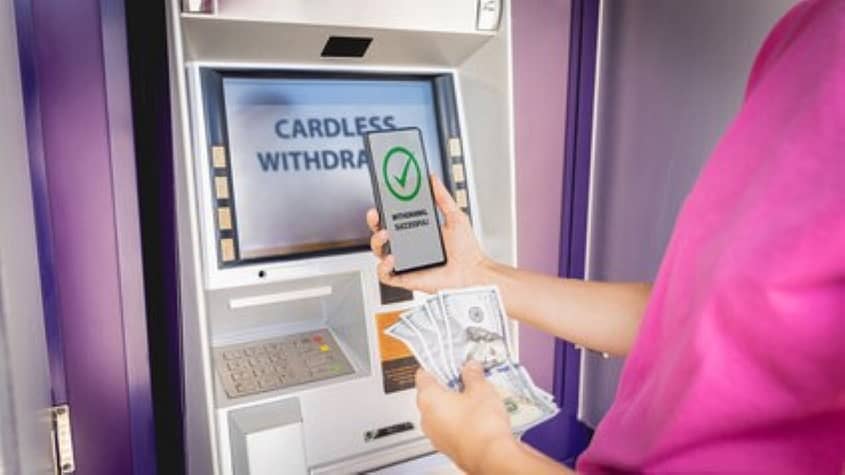In recent years, the concept of a cardless ATM has gained momentum as a convenient and secure way for consumers to access cash without the need for a physical debit or credit card. This article explores the innovative technology behind cardless ATMs, their benefits, and how they are shaping the future of cash transactions.
What is a cardless ATM?
Cardless ATMs, also known as mobile or digital wallet ATMs, allow customers to withdraw cash from an ATM without having to insert a physical card. Alternatively, consumers can start transactions with wearable tech like smartwatches, smartphones, or other mobile devices.
How does a cardless ATM work?
A cardless ATM works by using mobile banking apps and digital wallet technologies to enable users to withdraw cash from an ATM without the need for a physical debit or credit card. Firstly, here’s a detailed explanation of how a cardless ATM transaction typically operates:
1. Initiation of Transaction
- Mobile Banking App: The process begins with the user accessing their bank’s mobile banking app on their smartphone or other mobile device.
- Selection of Cardless Withdrawal: Within the app, the user selects the option for cardless ATM transactions, often found under services or withdrawals.
2. Generation of One-Time Code
- Authentication: The user verifies their identity through the mobile banking app using methods such as a PIN, fingerprint, or facial recognition.
- Generation of Code: Upon successful authentication, the app generates a unique one-time transaction code (e.g., numerical code or QR code) specific to the desired withdrawal amount and ATM location.
3. Visit the Cardless ATM
- Locate a Cardless ATM: The user uses the app’s ATM locator feature to find a nearby ATM that supports cardless transactions.
- Starting of Transaction: At the ATM, the user selects the option for cardless transactions on the screen.
4. Authentication at the ATM
- Input of Transaction Details: The user enters the necessary transaction details on the ATM screen, which may include the amount to withdraw and the generated one-time code.
- Verification: User transaction codes are authenticated by the ATM system to make sure they are genuine.
5. Cash Withdrawal
- Dispensing of Cash: Upon successful verification of the transaction code, the ATM dispenses the requested amount of cash to the user.
Benefits of Cardless ATMs
- Convenience
Users can access cash at any time, even if they forget their physical cards.
There is no need to carry physical cards, reducing the risk of loss or theft. - Security
Enhanced security with unique transaction codes that expire after use.
Reduced risk of card skimming or fraudulent activities associated with physical cards. - Accessibility
Enables cash withdrawals for individuals who may not have physical cards on hand.
Improves accessibility for users with disabilities who rely on mobile devices for transactions.
How to Use a Cardless ATM
Using a cardless ATM is straightforward:
1. Open the mobile banking app linked to your account.
2. Navigate to the cardless ATM feature and select “Withdraw Cash.”
3. Generate a unique transaction code or QR code.
4. Visit a cardless-enabled ATM and select the cardless transaction option.
5. Enter the generated code or scan the QR code at the ATM.
6. Follow on-screen prompts to complete the transaction and withdraw cash.
See more : How atms work?
Future Trends and Innovations
Moreover, the evolution of cardless ATM technology is driven by enhancements in user comfort, security measures, and mobile technology.
Here are some future trends and innovations shaping the world of cardless ATMs:
1. Biometric Authentication
One of the most significant trends in cardless ATM technology is the adoption of biometric authentication methods. This includes using fingerprints, facial recognition, or iris scanning to verify the identity of users. Biometric authentication enhances security by replacing traditional PINs or passwords, making transactions more secure and convenient.
2. Wearable Technology Integration
As wearable devices like smartwatches gain popularity, we can expect cardless ATM technology to integrate seamlessly with these gadgets. Users may soon be able to initiate transactions directly from their smartwatches, further streamlining the cash withdrawal process.
3. Blockchain and Cryptocurrency Integration
Cardless ATM transactions could be completely transformed by combining blockchain technology with cryptocurrency. Users may benefit from improved security, transparency, and lower transaction costs while using cardless ATMs to access cash by utilizing blockchain’s decentralized ledger technology.
4. Artificial Intelligence (AI) for Personalized Banking
AI-powered algorithms can analyze user behavior and preferences to offer personalized banking experiences. In the context of cardless ATMs, AI can predict cash withdrawal patterns, suggest optimal withdrawal amounts, and provide real-time financial insights to users.
5. Enhanced Security Measures
It is anticipated that advanced security features will be incorporated into future cardless ATM systems to counter new cyber threats. This includes multi-factor authentication, encryption technologies, and continuous monitoring of transactions to detect and prevent fraudulent activities.
6. Contactless NFC Payments
Integration with Near Field Communication (NFC) technology will enable contactless transactions at cardless ATMs. Users can simply tap their smartphones or smart cards against the ATM’s NFC reader to initiate withdrawals, reducing physical contact and enhancing convenience.
7. Global Expansion of Cardless ATM Services
The global adoption of cardless ATM services is expected to increase, providing greater accessibility to individuals in remote or underserved areas. Technological developments in digital banking infrastructure and mobile communication will enable this expansion.
8. Focus on User Experience (UX) Design
Future cardless ATM interfaces will prioritize user experience, offering intuitive and visually engaging designs. Features such as voice commands, gesture-based controls, and real-time transaction updates will enhance usability for all users, including those with disabilities.
Pros and Cons of Cardless ATM Transactions
| Pros | Details |
| Convenience and Accessibility |
|
| Enhanced Security Features |
|
| Faster and Efficient Transactions |
|
| Alternative for Forgotten or Lost Cards |
|
| Cons | Details |
| Dependency on Technology |
|
| Security Concerns |
|
| Limited Acceptance |
|
| User Experience Challenges |
|
| Transaction Limits and Restrictions |
|
Examples of cardless ATM accounts
Cardless ATM transactions are facilitated through various banking apps and platforms that offer innovative solutions for accessing cash without a physical card. Here are examples of financial institutions and services that provide cardless ATM accounts:
1. Chase Bank: Chase Mobile App
– Chase Bank allows customers to perform cardless ATM withdrawals using the Chase Mobile app.
– Users can generate a one-time access code through the app and use it at participating Chase ATMs for cash withdrawals.
2. Wells Fargo: Wells Fargo Mobile App
– Wells Fargo offers cardless ATM access through its mobile banking app.
– Customers can request a one-time access code or use biometric authentication (such as fingerprint or facial recognition) to authorize transactions at Wells Fargo ATMs.
3. Bank of America: Mobile Banking App
– Bank of America’s mobile banking app supports cardless ATM transactions.
– Users can initiate withdrawals by generating a digital token or QR code within the app and scanning it at Bank of America ATMs.
4. Citi: Citi Mobile App
– Citi Bank enables cardless ATM transactions through its mobile app.
– Customers can use the app to pre-stage withdrawals and generate a secure PIN to complete transactions at Citi ATMs without using a physical card.
5. PNC Bank: Virtual Wallet App
– PNC Bank offers cardless ATM access through its Virtual Wallet app.
– Users can initiate cardless transactions by selecting the option within the app and completing the withdrawal process at PNC ATMs.
6. U.S. Bank: Mobile Banking App
– U.S. Bank’s mobile banking app supports cardless ATM withdrawals.
– Customers can use the app to request a one-time access code or use other secure authentication methods to access cash at U.S. Bank ATMs.
7. Ally Bank: Ally Mobile App
– Ally Bank provides cardless ATM functionality through its mobile app.
– Customers can initiate cardless withdrawals by generating a unique code within the app and using it at Ally Bank ATMs.
These examples demonstrate how major banks and financial institutions are integrating cardless ATM features into their mobile banking apps. This offers customers a secure and convenient way to access cash without physical debit or credit cards.
Conclusion
Cardless ATMs represent a significant advancement in banking technology, offering consumers a secure, convenient, and accessible way to withdraw cash without physical cards. Cardless ATMs have the potential to revolutionize banking and change the way people transact with cash because of their many advantages and creative potential.
FAQ’s
Cardless ATMs protect user information by using special transaction codes and authentication techniques.
Most cardless ATMs require users to have a bank account linked to a mobile banking app that supports cardless transactions.
Cardless ATMs use one-time transaction codes that expire after use, reducing the risk of unauthorized access or fraudulent activities.
Users without smartphones can still access traditional ATMs using physical debit or credit cards.
The availability of cardless ATM services may vary by country and banking institution. Check with your bank for international cardless ATM options.

